|
XIIth Triennial Congress Auckland New Zealand Nov 2005
President's Closing summary
'Looking Back'
2003 Interim ICMM Meeting
XIIth Triennial Congress

The 2005 Triennial Congress was held at Auckland, New Zealand in November 2005. It was co-hosted by the New Zealand National Maritime Museum and the Royal NZ Navy Museum. 62 delegates, 15 partners and 12 speakers attended.
Monday 7 November
Registration, Icebreaker function held at the NZ National Maritime Museum including traditional Maori welcome.
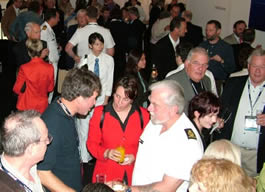
Icebreaker.
|
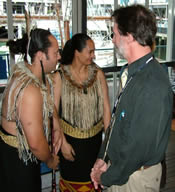
Stu Parnes is welcomed.
|
Tuesday 8 November
Plenary sessions. Evening cocktail function as guests of the Royal New Zealand Navy included Beat the Retreat by the Band of the Royal NZ Navy.
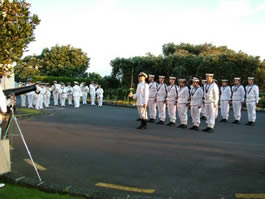
Beat the Retreat Ceremony.
|
|
Wednesday 9 November
Plenary Sessions
Thursday 10 November
Plenary sessions including AGM of the ICMM. Gala Dinner held in the foyer of the Auckland War Memorial Museum. Guest speaker Max Cryer.
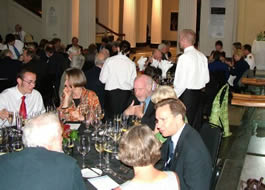
|
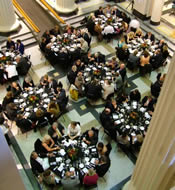
|
Congress Dinner 'A Taste of New Zealand'. |
Friday 11 November
Sea Day. A day afloat in HMNZS RESOLUTION and visit to the restoration site of SS TOROA and a modern boat building yard.
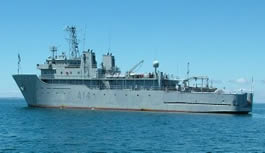
HMNZS Resolution.
|
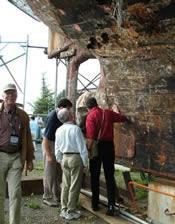
SS Toroa.
|
A big thanks to the congress sponsors and supporters:
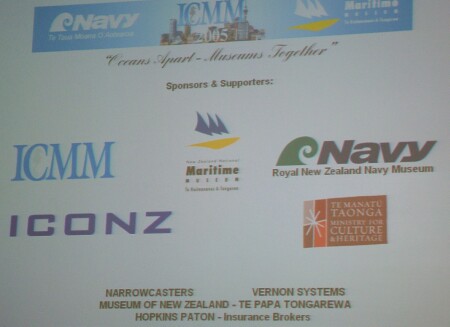
(Photos above by L Robbins)
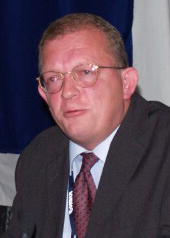
President's Closing Summary
What intense days we experienced
in Auckland,
New Zealand, and what exciting and splendid papers
we heard.
Over the three days of plenary sessions
we were served a superb Pacific dinner with a
rich variety of dishes:
| 1. |
The maritime heritage
of Oceania seen from a Pacific, as well as
from a European point of view;
|
| 2. |
The work with history and culture
of indigenous people;
|
| 3. |
Yachting and Leisure sailing,
and finally;
|
| 4. |
The challenges that maritime
museums are facing. |
To me - as I think to anyone from
overseas who has for the first time visited this
part of the world - some of the sessions in the
conference were really eye openers. I will never
forget the opening keynote lecture by Professor
Kerry Howe on The Last Great Migration - The Human
Discovery of the South Pacific and New Zealand
. In his splendid presentation Kerry Howe demonstrated
just how fruitful and exciting science can be
if you use an interdisciplinary approach. I am
sure that I will not be the only one to take Kerry
Howe's book on the theme when going home from
New Zealand .
And I am equally sure that many
of the participants in this conference also found
great inspiration in Dr. Nigel Rigby's paper that
in contrast to Howe's broad overview on the Polynesian
story went much closer to Cook and Vancouver 's
encounters in the Pacific North West. In a later
session Adriano Beca-Gil supplied the European
angle from a Portuguese point of view in his exciting
overview: The other side of Tordesillas - East
meets West at Sea . Still later John Robson asked:
What Cook could have achieved if he had had GPS?
- and Robson answered that Cook perhaps would
have been able to map the entire Pacific in such
a manner, that there would not have been any minor
mistakes left for Larry Robbins to correct!
In a really thought provoking paper,
Sir Tipene O'Regan combined the European and the
Pacific points of view in a way that almost drew
the overall conclusion on all the papers just
mentioned and at the same time gave valuable insights
in Polynesian maritime technology and way of thinking.
In the latter respect Sir Tipene
also added further dimensions to the papers of
Kate Vusoniwailala and Tarisi Vunidolo on Ocean
of Islands : The Importance of Ocean-going Waka
in Pacific Museum Collections and John Waight
on The Saltwater Collection: An Australian Viewpoint
. Both of these papers were dealing with the ways
in which the culture of indigenous people in this
part of the world are now becoming the basis of
new museums and museum collections.
That the indigenous Pacific culture
is rich and interesting was clearly demonstrated
by Dr. T.L. Rodney Wilson in his informative and
promoting paper on the Vaka Moana exhibition that
will travel around the world in the years to come.
I am sure that a great number of the future visitors
will find the inter-disciplinary, inter-institutional
and international approach of the exhibition fruitful,
inspiring and exciting.
But dealing with the history and
culture of indigenous people also means dealing
with ways of thinking and a variety of taboos
that might be difficult for outsiders to understand.
Dr. Seddon Bennington gave all of us a valuable
insight in these things and his final remark is
indeed true in all relations between different
cultures: “In another person's cultural
world we shall listen carefully and follow with
trust and understanding”.
Harold Kidd's paper on Early Leisure
Boating in New Zealand and Daina Fletcher's paper
on Interpreting Adventure - pushing the boundaries
of Museum Practice were dealing with the history
of yachting and sailing which also are themes
finding their way into maritime museums all over
the world. Hanna Hagmark-Cooper wondered whether
there would also be a woman's place in maritime
museums - and she gave the answer herself: Of
course there is. I can just add: Yep, we couldn't
miss them!
Even further into museums business
came Burt Logan in his paper on the work at the
USS Constitution Museum to engage family audiences.
And then we entered the world of museum challenges
in the three sessions with the rather provoking
title Maritime Museums - Sink or Swim . The keynote
paper by Paul Thompson on The Reinvention of the
Wellington Maritime Museum as the Museum of City
and Sea plus the inputs from Harry de Bles, Dan
Finamore, Stephen Riley, Peter Neill, Kevin Jones
and John Kearon gave us all hope that we may neither
sink nor have to swim. If we can find the right
approach it is still possible to set sail into
a bright new future.
The short reports from South Australian
Maritime Museum , the Dutch Museums , Edwin Fox,
Narrowcasters, Sydney Heritage Fleet, National
Maritime Museum Cornwall, Queensland Maritime
Museum and New Zealand Shipwreck Explorers complete
the picture of the variety of dishes that we were
served over the three busy but satisfying days.
I feel sorry for those ICMM members
who did not have the chance to go to New Zealand
and be part of this successful conference that
once again has demonstrated just how much maritime
museum people have to share around the sea that
connects us all.
On behalf of all of us I would like
to thank the Programme Committee - Stephen Riley,
Mary-Louise Williams and Larry Robbins - for a
fantastic Pacific “dinner”. You have
all done a great job, thank you so much. I will
also like to express our gratitude to all the
speakers for providing us with such great papers,
to the chairmen of the sessions for running things
so smoothly and to everyone in the audience for
their attention, interest and participation in
this conference that was so extraordinarily well
organized and hosted by David Wright of the Royal
New Zealand Navy Museum and Larry Robbins of the
New Zealand National Maritime Museum. A wholehearted
thank you from all of us to all of you for a fantastic
conference.
Morten Hahn-Pedersen
President, International Congress of Maritime
Museums
XIIth Triennial Congress - Looking Back
Larry Robbins, NZ National Maritime Museum (NZNMM)
'It seemed like a good idea at the time' was the thought that ran through my mind as the opening day of the Congress relentlessly approached. Three years before we had bid for this Congress and now it was about to happen. Fortunately we had engaged, from the outset, a very capable organizing company CMSL (Conference Management Services Ltd), and what a sensible move that was; in the final weeks we would probably have been able to cope with the administration, but the two host-museums would have had to close their doors for the duration! CMSL managed the administrivia, bookings, arrangements for speakers, changes, and so on, in a calm efficient manner. The organizing committee met a few times and communicated by telephone, fax and email as required and slowly it all came together.
There were a few complications. The Prime Minister, who in New Zealand is also the Minister for Culture and Heritage, agreed at the end of 2004 that she would open the Congress if she could, but advised that a final decision would have to wait until after the general election which was due sometime prior to the Congress. Of course the chosen election date of 18 September was a little close to the opening date for comfort, but in a small country we could be flexible. Then, due to the close result it took a month to form a government. As soon as the result was announced I was on the phone to the PM's office. That the State Opening of Parliament was programmed for the same day as our opening was rotten luck, and the PM's Secretary sounded genuinely sorry. I had to agree though that Parliament should indeed take precedence in the PM's diary.
I was asked if the Associate Minister would be an acceptable substitute. Hon Judith Tizard is the MP for the area in which the Museum is located and she is a good friend. Of course she would be very acceptable. The secretary warned me that she could only come if the opposition agreed to her being granted leave but as the PM had confirmed that this was an official engagement and a commitment had been made, this was granted. The Associate Minister opened the Congress with an excellent speech and things continued well from there on.
Having had the right to hold the Congress confirmed at the Falmouth meeting in 2003, we invited our sister museum, the Royal NZ Navy Museum - based on the opposite side of Auckland Harbour - to join us as co-host. They readily agreed, and the opportunity to work more closely with our friends there was a very definite plus for our museum - and hopefully for them too. The Navy put its full support behind the Congress, offered to host an evening function and agreed to provide a ship for a sea-day. Other assistance, including some financial support was also forthcoming.
We decided that we would stage an exhibition to open with the Congress. This was to form part of the NZNMM's regular series of 'temporary' exhibitions and will run to October 2006. Work was split between the two museums and stories from both sides of the maritime spectrum were to be told. Each museum was responsible for writing its stories and providing the artefacts. The Navy have therefore lent us some wonderful and precious items including some silverware from HMS N ew Z ealand (1908) and a piu-piu (maori skirt) given to the captain and worn at the Battle of Jutland. We have some of our treasures on display also, including a piece of ballast from Cook's ENDEAVOUR and a two-piece bathing suit donated by a volunteer - which apparently fitted her when it was new, 40 years ago! I hope that delegates will agree that the result is a source of justifiable pride to both of the co-hosts.
With around 62 delegates, 15 partners plus speakers who were not attending the Congress per se, this was a relatively small congress but the size allowed us some flexibility to do things we wanted to do. For example, we mustered a number of volunteers, and everyone who had advised us of flight details was met at the airport. This worked well and only one couple were missed. Likewise we were able to seat the delegates at tables, restaurant style, during the sessions rather than in serried rows.
It was remarkable that from the outset the delegates formed into an homogenous group and there was a 'buzz' from day one. President Morten has commented about the papers that were presented. We aimed for variety and for notable keynote speakers and were blessed in both regards.
It was not all "work" though. The Congress opened on Monday evening with a social function in the museum galleries. This included a formal maori Maori welcome lead by the museum's Ngati Whatua representative, and a speech of welcome from Acting President Mary-Louise Williams. Delegates also had the opportunity to view the exhibition.
After the Tuesday sessions the delegates boarded an historic ferry GLEN ROSA (1949) and were transported across the harbour to the Naval Base. Most delegates eschewed the bus and walked up to the Wardroom. They had not reckoned with " Monowai Hill" but most agreed that the view from the Wardroom was worth it! The navy's hospitality was generous and the performance of 'Beat the Retreat' by the RNZN Band, with paraded honour guard, was greatly appreciated and brought the evening to a fitting close.
The formal congress dinner was held in the foyer of Auckland Museum , an ornate neo-classical building, on the Thursday evening after the plenary sessions had completed. The food, prepared and served by the NZNMM's caterers, Dawsons , was superb, presenting the advertised 'Taste of New Zealand'. A local personality, Max Cryer, presented a witty and entertaining address on 'English as she is spoke'. Unfortunately the acoustics were a little difficult, and apparently New Zealanders speak a little too quickly for some of our visitors so some of the humour was lost. However this did not detract from a wonderful evening of good food, good wine, and good company in pleasant surroundings.
Friday's weather was perfect. Sunny with clear skies and warm late spring temperatures. The delegates gathered in the museum and watched as HMNZS RESOLUTION, the Royal NZ Navy's hydrographic/oceanographic survey ship berthed nearby. One group embarked into the ship whilst another headed off by bus. The seaborne group enjoyed further naval hospitality, tours of the ship and watched exercises as the ship made its way northwards to the Whangaparaoa Peninsula where they were treated to a Kiwi barbecue lunch.
Meanwhile the bus team visited the site where an early 20 th century double-ended steam ferry, SS TOROA, is being restored. The TOROA Preservation Association Society is an Associate Member of ICMM and the members were keen to show their ship to the delegates. ICMM exists, amongst other reasons, to facilitate networking and whilst some delegates simply gaped at the magnitude of the task, others quickly got into deep discussions with their hosts and had to be dragged back onto the bus for the next part of the tour - a visit to a modern boat building site where a number of very modern, very expensive vessels were being built for the European markets. The contrast with TOROA could not have been greater!
The bus group arrived at Whangaparaoa at lunchtime where they were met by a local utility craft and speedily taken out to RESOLUTION, laying at anchor offshore. Fortunately it was a calm day as the rope ladder into the ship, although of only a few rungs, certainly added to the experiences chalked up during the Congress! However all managed it safely and were soon enjoying their barbecue lunch as the first group piled into the boat, repeating the shore visits and activities in reverse. Frankly, the RNZN spoiled us and we had a wonderful day - only marred for the afternoon bus group when the bus air-conditioning failed!
The evaluation forms indicate that the delegates, for the most part, enjoyed the congress. Negatives? A suggestion that more free time to enjoy Auckland could have been programmed in, and a suggestion that we could have had more papers on local matters. Some found it a little expensive especially when added to the travel costs. All valid points but with a better than 97% approval rating, I think overall we can say 'Object Achieved' . though we are not in a hurry to repeat the exercise!
2003 Interim ICMM Meeting
The 2003 Interim ICMM Meeting was held at National Maritime Museum Cornwall, in Falmouth, England: 8-12 October 2003. The brand-new museum opened in February 2003 as a satellite of the NMM in Greenwich. Stephen Riley and Harry de Bles acted as 2003 Event Organizers for ICMM in conjunction with local staff.
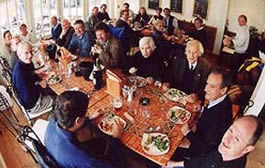
Some of the ICMM delegates enjoying lunch at Mylor Marina. (Photo: Carlos Pedro Vairo)
|
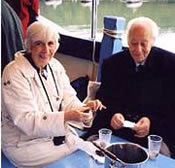
Nuria and Javier Pastor celebrating their 50th wedding anniversary, sharing fresh mussels in Falmouth Harbour.
|
BACK
TO TOP
|